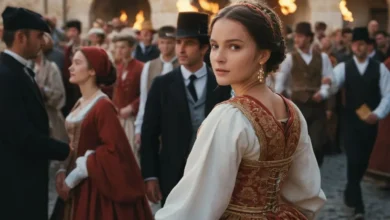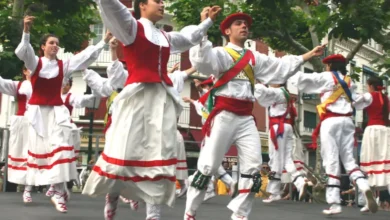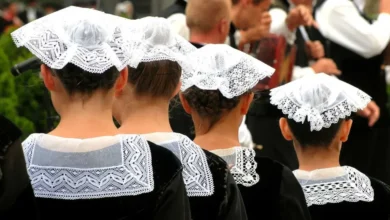Picture a sea of white lace rising like delicate towers above a crowd in western France — not at a royal wedding, but at a village festival in Brittany. These are the Breton coiffes, extraordinary headdresses that once crowned every woman’s head from girlhood to old age. Far more than fashion, these intricate creations were walking declarations of identity — telling you exactly where a woman was from, whether she was married, and even how wealthy her family was.
In this article, we’ll unravel the mystery, history, and artistry behind Brittany’s most iconic cultural symbol. You’ll discover why some coiffes soared sky-high, how lace became a language, and why these dazzling headdresses still matter today — long after they left daily life. Get ready to fall in love with lace that tells stories.
What Exactly Is a Breton Coiffe?
A Breton coiffe is a traditional lace or embroidered headdress worn by women in Brittany, a Celtic region in northwestern France. It’s not a hat or a simple bonnet — it’s a complex, often sculptural, piece of wearable art.
These headdresses were made from fine linen, cotton, or muslin, stiffened with starch, and adorned with handmade lace or needlework embroidery. Their shapes varied wildly — from tall cylinders to wide wings — depending on the village.
See also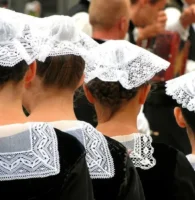 The Delicate Crowns of Coiffes Bretonnes: Brittany’s Lace Legacy of Pride and Craft
The Delicate Crowns of Coiffes Bretonnes: Brittany’s Lace Legacy of Pride and CraftMost importantly, the coiffe was never just decorative. It served as a social ID card:
- It signaled your specific village or region
- It revealed your marital status
- It hinted at your family’s wealth
- It marked the occasion — everyday wear, Sunday best, or mourning
Wearing the wrong coiffe in the wrong place? That would be like showing up to a job interview in pajamas — a serious social faux pas.
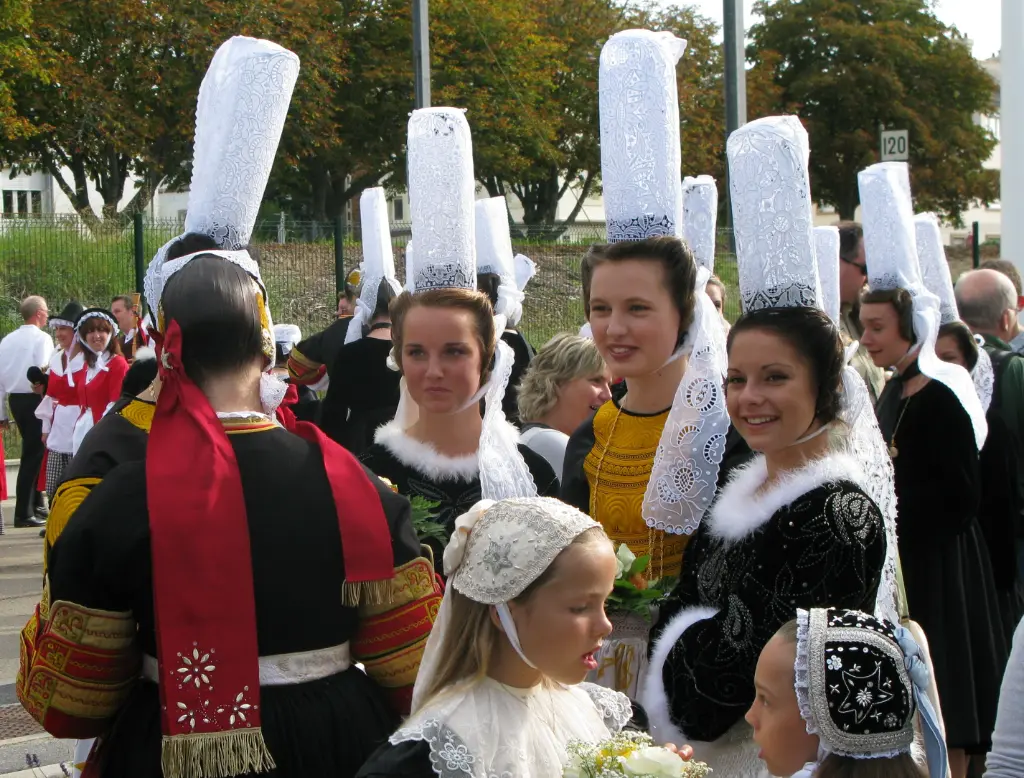
A Brief History: From Humble Bonnets to Cultural Icons
The story of the Breton coiffe didn’t start with lace towers. It began simply — and grew into something spectacular.
Roots in Modesty and Practicality
In medieval times, Breton women wore simple linen caps or hoods, mostly for modesty and to keep hair clean while working. Think of them as the 15th-century equivalent of a hair tie.
See also Discovering the Elegance of Traditional Clothing in France
Discovering the Elegance of Traditional Clothing in FranceAs trade routes opened in the 17th and 18th centuries, finer fabrics and lace-making techniques arrived in Brittany. Wealthier families began embellishing their headwear. What was once practical became a canvas for artistry — and competition.
The Golden Age: 1850–1930
The late 19th century was the coiffe’s heyday. With regional pride surging against French centralization, villages doubled down on their unique styles.
Ethnographer René-Yves Creston documented over 1,000 distinct coiffe styles across Brittany — sometimes changing from one village to the next (Creston, 1978). This wasn’t fashion. It was identity armor.
By the early 20th century, some coiffes — especially in Bigouden country — began growing taller. Why? Local legend says it was defiance after revolutionaries destroyed church steeples. “They took our steeples,” women supposedly declared, “so we’ll carry them on our heads!”
The Secret Language of Lace and Ribbons
Every stitch, fold, and ribbon on a Breton coiffe carried meaning. To “read” a coiffe was to understand the woman wearing it.
Village Codes: Your Head, Your Hometown
The shape alone could pinpoint your origin:
- Tall cylinder? You’re from Pays Bigouden.
- Wide butterfly wings? You hail from Fouesnant.
- Boxy and sober? You’re likely from Léon.
- Long shoulder lappets? You’re from around Auray.
At markets or festivals, you could “map” the crowd just by looking up.
Marital Status: Ribbons Tell All
Ribbons weren’t just pretty — they were status signals.
- Young girls: Often wore colorful ribbons (blue, pink) tied in bows.
- Married women: Switched to black or dark ribbons, sometimes tied in a specific knot.
- Widows: Wore plain fabric coiffes — no lace, no color — called coiffes de deuil (mourning coiffes).
Wealth, Occasion, and Craftsmanship
- Everyday coiffes: Simple, sturdy, easy to wash.
- Sunday coiffes: Finer lace, more starch, perfect for church.
- Festival/Wedding coiffes: The most elaborate — sometimes taking weeks to make.
The amount and quality of lace directly reflected family wealth. More lace = more money.
Regional Styles: A Tour Through Lace Geography
Brittany’s diversity is written in lace. Let’s explore its most famous coiffes.
The Bigouden Coiffe: Brittany’s Sky-High Symbol
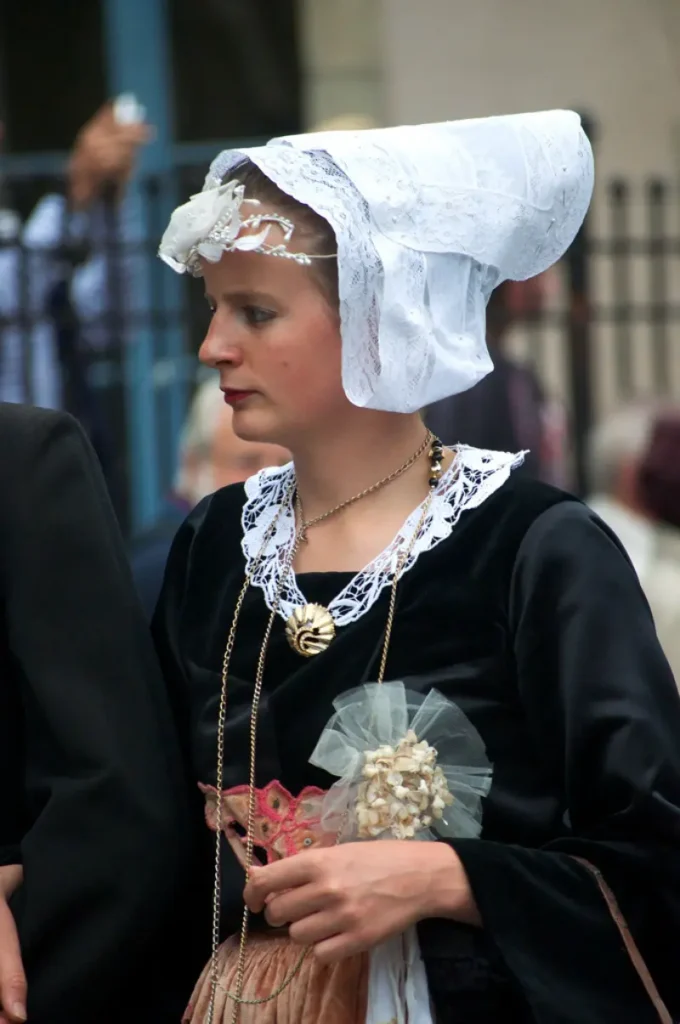
The Bigouden coiffe is the most iconic. From Pont-l’Abbé in southwestern Brittany, it’s known for its dramatic height — reaching up to 16 inches (40 cm) by the 1950s.
It didn’t start that way. In the 1920s, it was only a few inches tall. Its growth is attributed to friendly — or not-so-friendly — village rivalry. As one town’s coiffes grew taller, the next had to outdo them.
Today, it’s the unofficial emblem of Brittany. You’ll see it on postcards, logos, and festival queens.
The Giz Fouen: Wings of Fouesnant
In contrast to the Bigouden tower, the Giz Fouen coiffe from Fouesnant spreads horizontally. Two large lace “wings” extend from the sides of the head, fluttering like a butterfly.
Light, airy, and impossibly elegant, it’s considered one of the most beautiful — and technically challenging — styles to construct.
Léon’s Grace: Simplicity as Sophistication
In the devout northern region of Léon, coiffes were more restrained. Think clean lines, less volume, and emphasis on finely embroidered bonnets beneath the lace.
The Saint-Pol-de-Léon style reflects the area’s pious culture — beauty through subtlety, not spectacle.
Vannetais Variety: Where Every Town Had Its Own
Around Vannes, styles changed every few miles. The Auray coiffe, for example, frames the face with lace panels that cascade over the shoulders like waterfalls.
This region proves that “Breton coiffe” isn’t one thing — it’s hundreds.
| Region | Signature Coiffe | Key Feature |
|---|---|---|
| Pays Bigouden | Bigouden Coiffe | Towering vertical cylinder |
| Fouesnant | Giz Fouen | Horizontal lace “wings” |
| Léon | Saint-Pol Style | Boxier, minimalist, embroidered bonnet |
| Vannetais (Auray) | Auray Coiffe | Face-framing with shoulder lappets |
The Artisans: Brodeuses, Repasseuses, and the Magic of Starch
Creating and maintaining a coiffe was an art form — requiring specialized skills passed down through generations.
The Brodeuse: Lace Artist
The brodeuse (embroiderer) created the lace patterns — floral motifs, geometric designs, sometimes symbolic elements like wheat for fertility or waves for the sea.
Many used needle lace — stitching directly onto fabric — or bobbin lace, weaving threads on small wooden bobbins. Both required immense patience and precision.
The Repasseuse: Architect of Air
The real magician was the repasseuse — the ironer and starcher.
Her tools:
- A charcoal-heated flatiron
- Dozens of tiny, specially shaped irons for curves and ruffles
- A secret starch recipe (often rice- or sugar-based)
Her process:
- Wash the delicate lace by hand.
- Soak it in starch until saturated.
- Partially dry it — damp enough to shape.
- Use the irons to press, curl, and sculpt every fold into rigid perfection.
One coiffe could take 6–8 hours to prepare. And it had to be redone weekly.
A Community Effort
Often, women gathered in courtyards to help each other starch and pin their coiffes. It was social time — gossip exchanged over steam and starch.
Why Did Daily Wear Disappear?
By the 1950s, almost no one wore coiffes daily. Several forces drove this change:
- Modernization: Cars, trains, and radios connected villages. Local isolation — and local styles — faded.
- Urban Migration: Young women moved to cities for jobs. Wearing a giant lace tower to the office? Not practical.
- World Wars: Fabric shortages and survival priorities made upkeep impossible.
- Changing Tastes: Post-WWII, international fashion (think Hollywood glamour) made traditional dress seem “old-fashioned.”
The last woman known to wear the Bigouden coiffe daily, Marie-Louise Le Berre, died in 2017 — marking the end of an era (Le Télégramme, 2017).
The Coiffe Today: From Heritage to Celebration
Though no longer everyday wear, the Breton coiffe is alive — and thriving — as a symbol of pride.
Festivals: Where Tradition Takes Center Stage
At events like the Festival de Cornouaille in Quimper or the Interceltic Festival in Lorient, you’ll see hundreds of women in full regalia.
Contests crown “Queens of the Coiffe” — judged not just on beauty, but on knowledge of tradition, dance skill, and the perfection of their lace.
Cercles Celtiques: Guardians of the Craft
Hundreds of Cercles Celtiques (Celtic Circles) across Brittany teach young people traditional dance, music, language — and costume.
Members painstakingly recreate coiffes using original patterns and techniques. They’ve saved skills like repassage from extinction.
Museums and Education
- Musée Bigouden (Pont-l’Abbé): Houses the world’s largest coiffe collection.
- Musée de Bretagne (Rennes): Explores coiffes in the context of Breton identity.
- Schools and workshops now teach lace-making to new generations.
Pop Culture & Fashion
Designers like Jean Paul Gaultier have referenced coiffes in runway shows. Photographers and artists use them as powerful visual symbols.
Some criticize this as appropriation. Most Bretons, however, see it as celebration — proof their heritage still inspires.
The Breton coiffe is more than lace on a head — it’s a monument to community, craftsmanship, and cultural courage. In a world racing toward sameness, these headdresses remind us that identity can be worn with pride, stitched with care, and passed down with love.
They tell us that a woman’s head can hold a village’s history. That starch can be as strong as steel. That tradition doesn’t die — it transforms.
Today, when a teenager pins on her grandmother’s coiffe for a festival, she’s not playing dress-up. She’s declaring: “I am Breton. I remember. I belong.”
So what can you do?
👉 Visit Brittany during festival season — witness the lace in motion.
👉 Support artisans — buy handmade lace or donate to cultural circles.
👉 Learn the stories — read, watch documentaries, share this article.
👉 Respect the roots — if inspired to create, credit the culture that birthed it.
Because the Breton coiffe isn’t just a relic. It’s a living legacy — and it’s waiting for you to look up and admire it.

